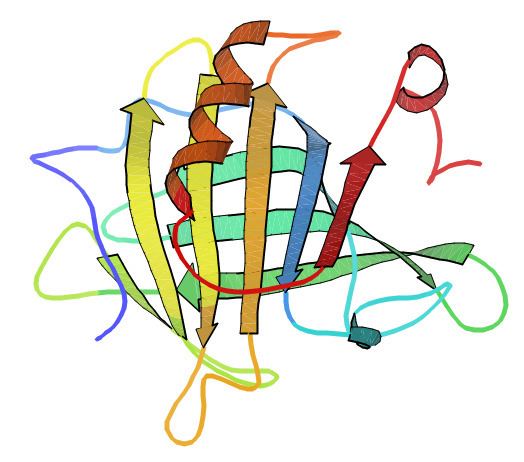 | ||
β-Lactoglobulin is the major whey protein of cow and sheep's milk (~3 g/l), and is also present in many other mammalian species; a notable exception being humans. Its structure, properties and biological role have been reviewed many times.
Structure and role
Unlike the other main whey protein, α-lactalbumin, no clear function has been identified for β-lactoglobulin. β-lactoglobulin is a lipocalin protein, and can bind many hydrophobic molecules, suggesting a role in their transport. β-lactoglobulin has also been shown to be able to bind iron via siderophores and thus might have a role in combating pathogens. A homologue of β-lactoglobulin is lacking in human breast milk.
Several genetic variants have been identified, the main ones in the cow being labelled A and B. Because of its abundance and ease of purification, it has been subjected to a wide range of biophysical studies. Its structure has been determined several times by X-ray crystallography and NMR. One such structure is shown on the right (from http://www.pdb.org entry 3BLG). β-lactoglobulin is of direct interest to the food industry since its properties can variously be advantageous or disadvantageous in dairy products and processing
Bovine β-lactoglobulin is a relatively small protein of 162 residues, with an 18.4 kDa molecular weight (1 dalton being defined as 1 unified atomic mass unit). In physiological conditions it is predominantly dimeric, but dissociates to a monomer below about pH 3, preserving its native state as determined by using NMR. Conversely, β-lactoglobulin also occurs in tetrameric, octameric and other multimeric aggregation forms under a variety of natural conditions.
β-Lactoglobulin solutions form gels in various conditions, when the native structure is sufficiently destabilised to allow aggregation. Under prolonged heating at low pH and low ionic strength, a transparent `fine-stranded' gel is formed, in which the protein molecules assemble into long stiff fibres.
Folding intermediates for this protein can be studied using light spectroscopy and denaturant. Such experiments interestingly show an unusual but important intermediate composed purely of alpha helices, despite the fact that the native structure is beta sheet. Evolution has probably selected for the helical intermediate to avoid aggregation during the folding process.
As milk is a known allergen (as listed in Annex IIIa of Directive 2000/13/EC), manufacturers need to prove the presence or absence of β-lactoglobulin to ensure their labelling satisfies the requirements of the aforementioned directive. Food testing laboratories can use ELISA (enzyme linked immunosorbent assay) methods to identify and quantify β-lactoglobulin in food products.
Laboratory polymerization of β-lactoglobulin by microbial transglutaminase reduces its allergenicity in children and adults with an IgE-mediated cow’s milk allergy.
